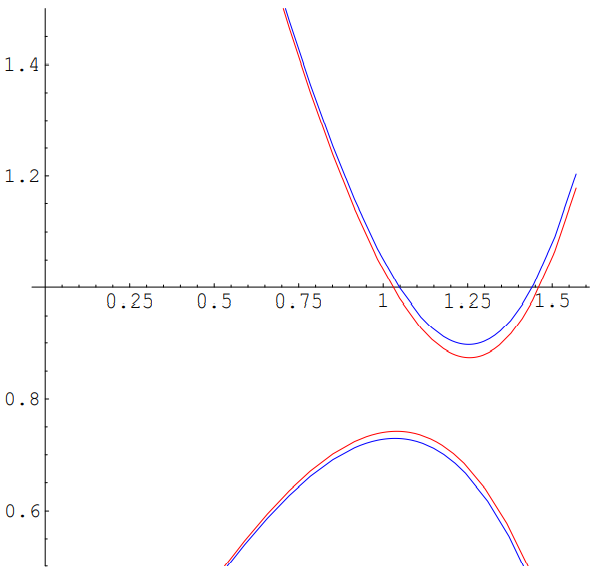11.8: Spherical Waves
( \newcommand{\kernel}{\mathrm{null}\,}\)
Consider sound waves in a very large room with absorbing walls. In the middle of the room (we will take the middle of the room to be the origin of our coordinate system, →r=0) is a

Figure 11.58: Both rainbows.
spherical loudspeaker, a sphere that produces an oscillating pressure at its surface (at radius R) of the form p0cosωt. What sort of sound waves are produced? It seems rather silly to use our plane wave solutions with space translation invariance for this problem, because this system has a symmetry under rotations about the origin. Instead, let us look directly at the wave equation and make use of the spherical nature of the problem. That is, assume that the solution has the form ψ(→r,t)=χ(|→r|,t). Putting this into the wave equation gives (with r≡|→r|)8 1v2∂2∂t2χ(r,t)=→∇2χ(r,t)=→∇⋅→∇χ(r,t)=→∇⋅(→∇r)∂∂rχ(r,t)=→∇⋅(→r/r)∂∂rχ(r,t)
=(→∇⋅→r/r)∂∂rχ(r,t)+(→∇r)⋅(→r/r)∂2∂r2χ(r,t)=[(→∇⋅→r)/r+→r⋅→∇(1/r)]∂∂rχ(r,t)+(→r/r)⋅(→r/r)∂2∂r2χ(r,t)=2r∂∂rχ(r,t)+∂2∂r2χ(r,t).
We can rewrite this in the following useful form: 1v2∂2∂t2χ(r,t)=1r∂2∂r2rχ(r,t).
Thus rχ(r,t) satisfies the one-dimensional wave equation.
We can now solve the problem that we posed above. The solutions for rχ have the form sin(kr±ωt) and cos(kr±ωt), where k=ω/v. Because the pressure at r=R is p0cosωt, we are interested in the combinations cos(kr−kR−ωt) and cos(kr−kR+ωt). These describe waves going outward from and inward toward the origin respectively. The appropriate boundary condition at infinity is to take the outgoing wave, so that the disturbance is produced entirely by the speaker. Thus χ(r,t)=p0Rrcos(kr−kR−ωt).
The general features of the solution, (11.174), are easy to understand. The wave-fronts, along which the phase of oscillation is constant, are spheres centered about the origin, as they must be because of the rotational symmetry. The waves move out from the origin at speed v. As they move outward, their local intensity must decrease, because the same amount of energy is being spread over a larger area. This is the reason for the 1/r in (11.174). If the amplitude falls as 1/r, the intensity of the wave falls as 1/r2, as it must. Though the physics is clear, the precise form of this solution is deceptively simple. In two dimensions, for example, it is not possible to find a solution to an analogous problem using the functions that you know from high school. In two dimensions, the amplitude of the wave must decrease roughly as 1/√r. The solutions to the two-dimensional wave equation with this property are called Bessel functions. You will learn about them in more advanced courses.
____________________
8If you have seen spherical coordinates, you may remember that you cannot compute the Laplacian, \boldsymbol{\vec{\nabla} \cdot \vec{\nabla}}}, simply as ∂2∂r2. You don’t need to remember the details here because we compute it from scratch for the function, χ(|→r|,t).

